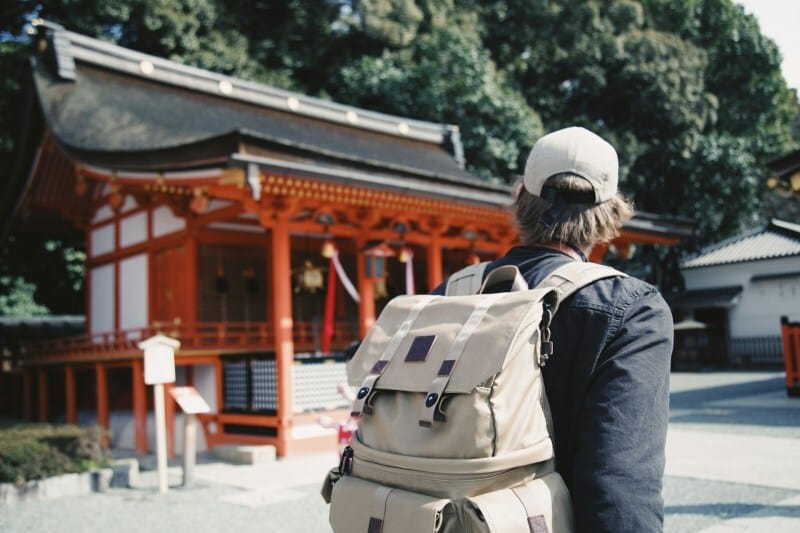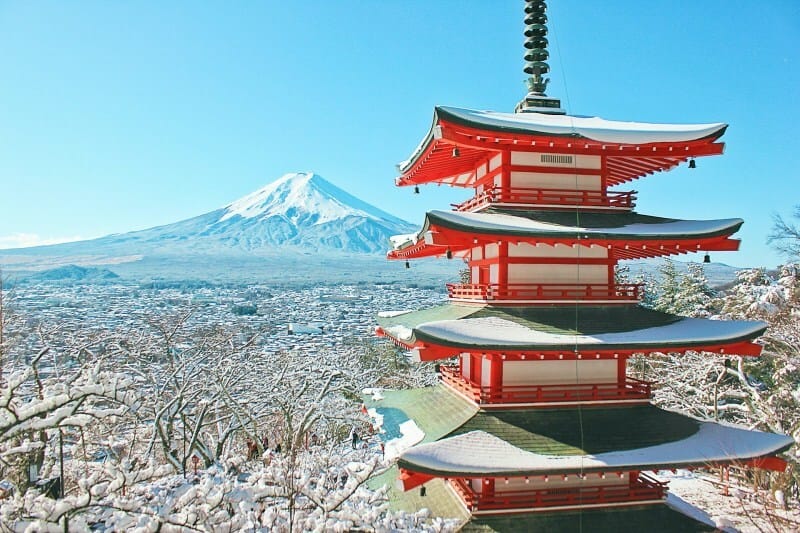Planning Japan by season is the simplest way to get big rewards from every day on the ground. Weather shifts, festival calendars, and crowd patterns all change the feel of a place more than any checklist ever will.
Pick your moment first, then build a route that matches that mood, whether you want petal-soft mornings in April, lantern-lit nights in August, or gold-and-crimson temple walks in November.
Start planning and book your route with tours to Japan, then use the seasonal planner below to match dates, regions and festivals to your pace.

Japan by season at a glance
Spring (March to May). Soft light, comfortable days, cool evenings. Cherry blossoms open earliest in the south and roll north over several weeks. In cities, aim for early morning park walks before picnics fill the lawns. Reserve stays near transport hubs because availability tightens around weekends and school breaks. If you miss peak bloom by a few days, you still get fresh greens and quieter paths.
Summer (June to August). Expect humidity on Honshu after the June rains, but long days and festival energy more than compensate. Think fireworks over rivers, taiko drums, and street food. For cooler air, head for coast and mountains or jump to Hokkaido, where wildflower fields and alpine hikes shine. Beach time is best around the Izu Peninsula, the Seto Inland Sea, or Okinawa if you want tropical water.
Autumn (September to November). Clear skies, low humidity, and foliage that turns gardens and mountain valleys into color studies. Kyoto and the Japan Alps are standouts. You will feel the weekends tighten again around peak color; plan early morning temple visits and save museums or markets for midday.
Winter (December to February). Crystal views in the cities, illuminations after dark, and deep powder in Hokkaido and Nagano. Even if you do not ski, onsen towns make perfect two-night bases. Pack a warm mid-layer and enjoy crowd-light days at headline sights.

Image by Rafael Hoyos Weht on Unsplash.
Where to go per season
Spring: classic arc with garden time
Start in Tokyo for three or four nights. Build mornings around parks like Shinjuku Gyoen or riverside walks, then add a clear-sky day trip to the Fuji area or Kamakura. Move to Kyoto for gardens and temples in smaller doses: early Arashiyama one day, sub-temples at Daitoku-ji another. Add Nara for deer-filled greens and lantern-lined lanes. If you want a cooler finale, finish in Kanazawa for Kenrokuen and old districts that photograph beautifully under spring light.
Summer: festivals, coast, and mountain air
Anchor your trip around one midsummer matsuri and let the rest flex with the heat. Tokyo delivers festivals and museum cool-downs; from there, ride north to Sendai or Aomori for big parades, or fly to Sapporo and wander Hokkaido’s flower fields near Furano and Biei. If you prefer the sea, base in Kamakura or the Setouchi coast for breezes and island ferries. Okinawa gives warm water and a slower rhythm if you want to end with beach days.
Autumn: color and culture
Combine Tokyo with Nikko for shrines in cedar forests, then ride west for Kyoto’s temple evenings and side streets that glow at blue hour. Add the Kiso Valley for quiet post towns along the Nakasendo or continue to Kanazawa for gardens framed by red maples. If you have time, fold in Hiroshima and Miyajima; the island’s torii at sunset is a perfect autumn scene.
Winter: clear views and hot springs
Use Tokyo for sharp-sky viewpoints and cozy food halls, then choose a snow module. Nagano offers snow resorts and easy onsen stays; Hokkaido adds bigger mountain terrain and a winter city vibe in Sapporo. Finish in Kyoto or Osaka for temples in crisp air and hearty street food. A night in Hakone or Kinosaki Onsen is a restorative bridge between city days.

Photo by Kaori Chin on Unsplash
Booking windows, budgets, and crowd strategy
When to reserve: For peak spring and autumn, secure key hotels three to four months out, longer if you want boutique stays or weekend nights. Summer festivals and ski weeks also book up early. Shoulder weeks can be kinder on price and pace.
Holiday hot spots: Late April to early May, mid August, and the New Year period compress demand. If your dates overlap, target early mornings for headline sights and plan travel days midweek.
Flexible days: Toss one float day into each week to follow good weather or shift a day trip. It saves money too, since you avoid last-minute scrambles.
Where to spend vs. save: Spend on location. A hotel near a big station or tram stop returns time every single day. Save on transfers by using IC cards and regional passes that fit your exact route rather than defaulting to a blanket pass.
Getting around without stress
The shinkansen is the cleanest way to move between regions. Book reserved seats for weekend and holiday hops, choose mid-morning departures for a gentle check-out, and treat the ride as a small picnic with an ekiben lunch. In cities, tap through gates with an IC card that also works in convenience stores and some lockers.
Regional trains and trams add texture and often drop you closer to neighborhoods than express buses do. When a bus is the better fit, stations make routes obvious and staff are happy to help if you show the destination name. Coin lockers are lifesavers on check-out days; luggage forwarding turns a long transfer into a light stroll.
Connectivity is simple with a pocket Wi-Fi or eSIM. Download offline maps for rural bits and keep station names in Japanese characters on your phone for quick show-and-tell at counters. Etiquette is part of the smooth feel: quiet voices on trains, no eating on local subways, shoes off in traditional stays.

Photo by bobby hendry on Unsplash
Packing lists that change with the weather
Spring: breathable layers, compact umbrella, light scarf for cool evenings, comfortable shoes for park paths. Camera or phone space for way too many blossom shots.
Summer: sun hat, high-SPF sunscreen, quick-dry clothing, electrolytes, and a small towel. A portable fan or cooling wipes help on humid days. Sandals for beach modules, but keep sturdy trainers for city walking.
Autumn: light jacket, packable rain layer, and shoes with grip for leaf-strewn paths. Neutral sweater that works at temples and nicer dinners.
Winter: thermal base layers, warm mid-layer, hat and gloves for nights, and an onsen kit bag with quick-dry towel and modest cover-up for walks to the bath.

Photo by Weiqi Xiong on Unsplash
Sample itineraries you can copy
Spring, 10 days: petals and gardens Day 1–4 Tokyo base with one Fuji or Kamakura day when skies are clear. Day 5 travel to Kyoto, evening stroll in Gion’s side streets. Day 6 early Arashiyama, afternoon tea or craft workshop. Day 7 sub-temples at Daitoku-ji, market picnic. Day 8 Nara day trip. Day 9–10 Kanazawa garden time and old districts, fly or rail out.
Summer, 10 days: festival plus breezes Day 1–3 Tokyo museums by day, festival evening. Day 4–6 Hokkaido base around Furano or Sapporo for cool air and flower fields. Day 7–8 Setouchi coast for island ferries and art, or Kamakura for beaches. Day 9–10 Osaka for river walks, food halls, and easy airport access.
Autumn, 12 days: color arc Day 1–3 Tokyo with a Nikko day trip. Day 4–7 Kyoto early gardens and evening illuminations. Day 8 Kiso Valley or Kanazawa. Day 9–10 Hiroshima and Miyajima. Day 11–12 Osaka wrap-up.
Winter, 9 days: clear-sky cities and hot springs Day 1–3 Tokyo viewpoints, markets, illuminations. Day 4–6 Nagano or Hokkaido snow module with onsen. Day 7–9 Kyoto or Osaka for temples, warm noodles, and a final slow evening.

Photo by Ryunosuke Kikuno on Unsplash
Small rituals that make trips better
Build one park picnic each week from a department store food hall. It slows lunch and puts you in the middle of local routines.
Choose one sunrise or one sunset per city and keep everything else flexible that day.
Learn and use a few phrases. A simple arigato delivered with eye contact changes interactions more than you expect.
Keep a tiny incidentals kit: coins for lockers, a foldable tote for market finds, and a handkerchief for temples and tea rooms where tissues feel wrong.
A season to remember
The best Japan trips feel calm even when you cover a lot of ground. Pick a season that matches your energy, craft a route that breathes, and let weather and whim steer a handful of days. You will come home with the highlights, yes, but also with small, unplanned moments that only happen when you travel at the right time and at your own speed.
The post Seasonal Japan Planner: Cherry Blossoms, Summer Festivals & Autumn Colors appeared first on Moss and Fog.
